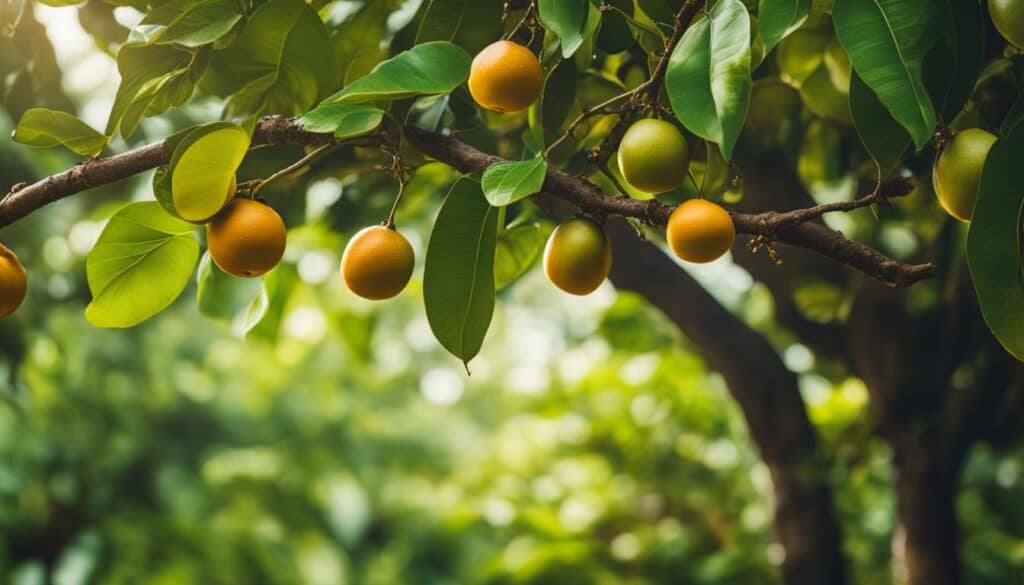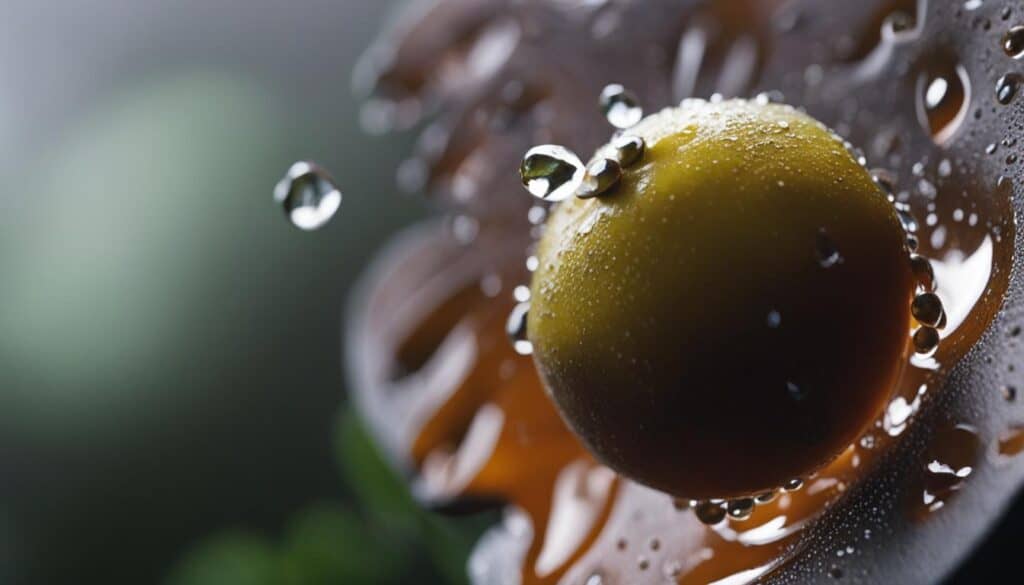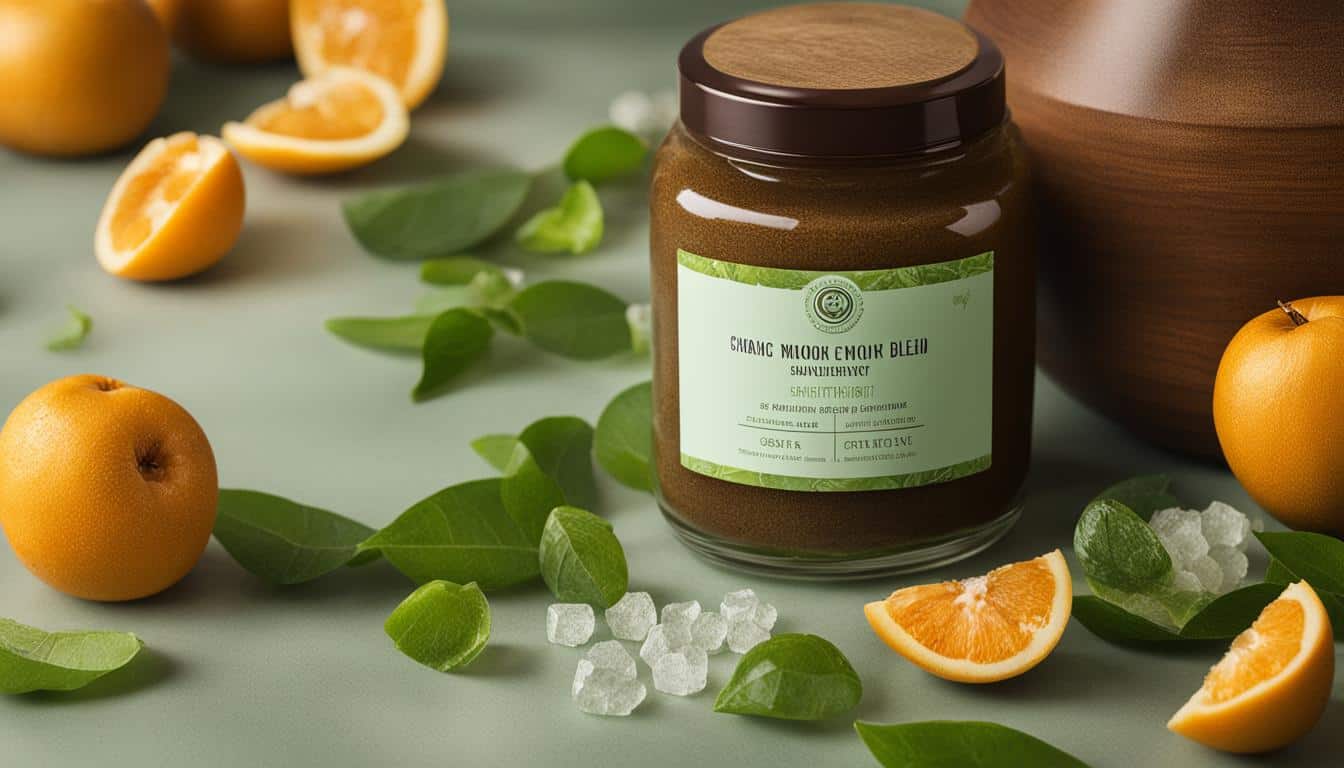Monk fruit, also known as Luo Han Guo, has gained popularity as a natural zero-calorie sweetener that can be used as a substitute for sugar in cooking and baking. But what exactly is monk fruit, and how does it compare to erythritol? Let’s dive into the world of monk fruit and explore its uses, benefits, and potential health effects.
Key Takeaways:
- Monk fruit is a natural, zero-calorie sweetener that can be used as a substitute for sugar.
- Erythritol is a natural carbohydrate that is often combined with monk fruit to create a granulated sweetener.
- Monk fruit has been used in traditional Chinese medicine for centuries to treat various ailments.
- Studies suggest that monk fruit may have anti-inflammatory, antioxidant, and potential anti-cancer properties.
- Monk fruit sweetener is low in calories, has a minimal impact on blood sugar levels, and is safe for diabetics.
What is Monk Fruit and Where Does it Come From?
Monk fruit, scientifically known as Siraitia grosvenorii, is a natural zero-calorie sweetener that is gaining popularity as a substitute for sugar in cooking and baking. This small vine fruit grows on the Siraitia grosvenorii plant and is known for its round, small, and green appearance. It has a sweet and juicy pulp and is low in calories, with just 0.25 calories per gram.
Monk fruit has a long history of traditional use in Chinese medicine for respiratory ailments and digestive issues. In recent years, it has been recognized for its potential as a sugar substitute due to its natural sweetness. Many food and beverage products now use monk fruit as a healthier alternative to sugar.
In cooking and baking, monk fruit can be used as a substitute for sugar, providing sweetness without the added calories. Its unique flavor profile makes it suitable for a variety of recipes, from desserts to beverages. Whether you’re following a specific diet or simply looking to reduce your sugar intake, monk fruit can be a versatile and delicious option.
What is Monk Fruit and Where Does it Come From?
Monk fruit, scientifically known as Siraitia grosvenorii, is a natural zero-calorie sweetener that is gaining popularity as a substitute for sugar in cooking and baking. This small vine fruit grows on the Siraitia grosvenorii plant and is known for its round, small, and green appearance. It has a sweet and juicy pulp and is low in calories, with just 0.25 calories per gram.
“Monk fruit has a long history of traditional use in Chinese medicine for respiratory ailments and digestive issues.”
Monk fruit has a long history of traditional use in Chinese medicine for respiratory ailments and digestive issues. In recent years, it has been recognized for its potential as a sugar substitute due to its natural sweetness. Many food and beverage products now use monk fruit as a healthier alternative to sugar.
In cooking and baking, monk fruit can be used as a substitute for sugar, providing sweetness without the added calories. Its unique flavor profile makes it suitable for a variety of recipes, from desserts to beverages. Whether you’re following a specific diet or simply looking to reduce your sugar intake, monk fruit can be a versatile and delicious option.
A Brief History of Monk Fruit and its Traditional Uses
The use of monk fruit in traditional Chinese medicine dates back centuries. This small green fruit, also known as Luo Han Guo, has been valued for its medicinal properties and is often used to treat various ailments. In traditional Chinese medicine, monk fruit has been renowned for its effectiveness in relieving coughs, soothing sore throats, and alleviating constipation.
Monk fruit is considered a symbol of longevity in Chinese culture and holds significance during the Chinese New Year festivities. It is believed to bring good luck and prosperity, and is often used as a decorative element in celebrations. Whether consumed as a sweet treat or displayed as a symbol, monk fruit holds a special place in Chinese customs and traditions.
Throughout history, monk fruit has been an integral part of traditional Chinese medicine and culture, revered for its healing properties and symbolic value. Today, monk fruit’s significance extends beyond its traditional uses, as it is now recognized as a natural zero-calorie sweetener that offers a healthier alternative to sugar.

The Traditional Uses of Monk Fruit in Chinese Medicine:
- Treating coughs and sore throats
- Relieving constipation
- Symbolizing longevity
- Festive use in Chinese New Year celebrations
Monk fruit has a rich history filled with both medicinal and cultural significance. As its popularity continues to grow, more people are discovering the benefits of incorporating monk fruit into their diets and lifestyles.
How Monk Fruit is Processed and Made into a Sweetener
Monk fruit sweetener is a popular alternative to sugar that offers a natural and zero-calorie option for those looking to reduce their sugar intake. But how is monk fruit transformed into a sweetener? Let’s dive into the process.
To create monk fruit sweetener, the fruit undergoes a series of steps including juice extraction and blending with a natural carbohydrate called erythritol. Firstly, the monk fruit is collected and dried to remove its moisture content. Once dried, the fruit is crushed to extract its juice, which contains the natural sweet compounds.
The extracted juice is then combined with erythritol, a sugar alcohol that provides bulk and texture to the sweetener. This mixture is processed and granulated into a powder or a granulated form, similar to regular sugar. The result is a sweetener that can be used as a substitute for sugar in baking, cooking, and beverages.
What sets monk fruit sweetener apart from other sugar substitutes is its natural origin and minimal impact on blood sugar levels. It is a suitable option for those following a low-calorie or low-glycemic index diet. Additionally, monk fruit sweetener has been gaining popularity among individuals looking to reduce their sugar intake without compromising on taste.
The Process of Making Monk Fruit Sweetener
| Step | Description |
|---|---|
| 1 | Collect and dry the monk fruit to remove moisture. |
| 2 | Crush the dried monk fruit to extract its juice. |
| 3 | Blend the extracted juice with erythritol, a natural carbohydrate. |
| 4 | Process and granulate the mixture into a powder or granulated form. |
By following this processing method, monk fruit is transformed into a sweetener that can be easily incorporated into various recipes and beverages. Whether you’re baking a delicious dessert or sweetening your morning coffee, monk fruit sweetener is a versatile and healthier option.
The Health Benefits of Monk Fruit: What Science Tells Us
Monk fruit sweetener has gained popularity not just for its sweet taste but also for the potential health benefits it offers. Scientific studies have shown that monk fruit sweetener possesses anti-inflammatory and antioxidant properties, making it a valuable addition to a healthy diet.
One of the key advantages of monk fruit sweetener is its minimal impact on blood sugar levels and insulin levels. Unlike regular sugar, monk fruit sweetener does not cause a rapid increase in blood glucose levels, making it suitable for those with diabetes or individuals looking to manage their blood sugar levels.
Furthermore, research suggests that monk fruit sweetener may have a positive effect on digestion and reduced inflammation. It has been linked to improved gut health and may help soothe digestive discomfort. Additionally, the antioxidant properties of monk fruit sweetener may contribute to better heart health and potentially even have anti-cancer effects.
While more research is needed to fully understand the extent of monk fruit sweetener’s health benefits, the existing studies indicate promising results. Incorporating monk fruit sweetener into your diet as a natural alternative to sugar may have positive effects on various aspects of your health.
| Health Benefits of Monk Fruit Sweetener | Scientific Evidence |
|---|---|
| Anti-inflammatory properties | Studies have shown that monk fruit sweetener exhibits anti-inflammatory effects, helping to reduce inflammation in the body (source). |
| Antioxidant properties | Research suggests that monk fruit sweetener contains antioxidants that help protect the body against oxidative stress and free radicals (source). |
| Improved digestion | Preliminary studies indicate that monk fruit sweetener may have a positive impact on digestion and gut health (source). |
| Better heart health | The antioxidant compounds found in monk fruit sweetener may have cardio-protective effects, promoting heart health (source). |
| Anti-cancer properties | Some studies suggest that the antioxidant properties of monk fruit sweetener may be linked to potential anti-cancer effects (source). |
The Nutritional Value of Monk Fruit Compared to Other Sweeteners
Monk fruit sweetener is a popular choice for those seeking a low-calorie alternative to sugar. Unlike refined sugar and artificial sweeteners, monk fruit sweetener has a minimal impact on blood sugar levels, making it a suitable option for individuals with diabetes or those looking to manage their blood sugar. It contains no carbohydrates or sugars, making it an ideal choice for those following a low-carbohydrate or ketogenic diet.
What sets monk fruit sweetener apart is its antioxidant compounds, which provide additional health benefits. These antioxidants can help protect the body against damage from harmful free radicals and may have anti-inflammatory effects. In comparison, refined sugar lacks these beneficial compounds and is known for its negative health effects, including increased risk of obesity and chronic diseases.
When compared to artificial sweeteners, such as aspartame or sucralose, monk fruit sweetener is a more natural option. Artificial sweeteners are often chemically processed and may have adverse effects on health when consumed in excess. Monk fruit sweetener, on the other hand, is derived from a natural source and undergoes minimal processing, making it a healthier choice for those looking to reduce their sugar intake.
The Antioxidant Value of Monk Fruit Sweetener
To further emphasize the benefits of monk fruit sweetener, let’s take a closer look at the antioxidant value when compared to other sweeteners:
| Sweetener | Antioxidant Compounds | Impact on Blood Sugar Levels |
|---|---|---|
| Monk Fruit Sweetener | High | Minimal |
| Refined Sugar | None | High |
| Artificial Sweeteners | None | No impact |
As shown in the table, monk fruit sweetener contains high levels of antioxidant compounds, while both refined sugar and artificial sweeteners lack these beneficial compounds. Additionally, monk fruit sweetener has a minimal impact on blood sugar levels, making it a healthier choice for those concerned about their blood sugar management.
Understanding the Glycemic Index of Monk Fruit: Is it Safe for Diabetics?
For individuals with diabetes, keeping blood sugar levels in check is crucial. One factor to consider when choosing sweeteners is their glycemic index (GI), which measures how quickly a food raises blood sugar levels. The glycemic index of monk fruit sweetener is remarkably low, making it a safe option for diabetics.
Studies have shown that monk fruit sweetener has minimal impact on blood sugar levels, thanks to its natural composition. Unlike refined sugar or artificial sweeteners, which can cause spikes in blood sugar, monk fruit sweetener provides a gradual release of glucose into the bloodstream. This slow-release effect helps maintain stable blood sugar levels, making it a valuable addition to the diets of those with diabetes.
Furthermore, monk fruit sweetener has also been found to potentially improve insulin sensitivity. Insulin sensitivity refers to how effectively the body’s cells respond to insulin, the hormone responsible for regulating blood sugar levels. By improving insulin sensitivity, monk fruit sweetener may aid in better blood sugar control and overall diabetes management.
The Glycemic Index of Monk Fruit Sweetener: A Comparison
Here is a comparison table showcasing the glycemic index values of various sweeteners, including monk fruit:
| Sweetener | Glycemic Index |
|---|---|
| Monk Fruit Sweetener | 0-1 |
| Honey | 58 |
| Agave Syrup | 15 |
| Coconut Sugar | 35-54 |
As seen in the table, monk fruit sweetener has a glycemic index of 0-1, indicating a negligible impact on blood sugar levels. This contrasts with other popular sweeteners like honey, which has a glycemic index of 58, and agave syrup, which has a glycemic index of 15. These higher glycemic index values can cause a more significant increase in blood sugar levels, posing challenges for individuals with diabetes.
In conclusion, monk fruit sweetener is a safe and suitable option for diabetics due to its low glycemic index. It provides a sweet taste without causing spikes in blood sugar levels, making it an excellent alternative to traditional sugar and other sweeteners. Remember to consult with a healthcare professional for personalized advice on managing blood sugar levels and incorporating monk fruit sweetener into your diet.

Conclusion
In conclusion, monk fruit erythritol is a versatile and natural sweetening agent that offers an array of benefits as a sugar alternative. With its zero-calorie content, it provides a guilt-free sweetness for those looking to reduce their sugar intake. Its keto-friendly properties make it a popular choice among individuals following a low-carb or ketogenic diet.
Not only does monk fruit erythritol offer a pleasant taste, but it also possesses potential health effects. Its anti-inflammatory and antioxidant properties contribute to improved overall well-being. Moreover, its minimal impact on blood sugar levels makes it suitable for individuals with diabetes or those monitoring their glucose levels. As a low-glycemic index sweetener, it supports stable blood sugar and insulin levels.
When comparing sugar alternatives, monk fruit erythritol stands out as a viable option. Unlike refined sugar and artificial sweeteners, it provides a healthier alternative without compromising on taste or sweetness. However, it is important to remember that individual preferences and health conditions should be considered when incorporating monk fruit erythritol into the diet.
FAQ
Is monk fruit erythritol?
No, monk fruit and erythritol are two separate substances. Monk fruit is a natural sweetener derived from the monk fruit plant, while erythritol is a sugar alcohol commonly used as a sugar substitute. Monk fruit sweeteners may blend monk fruit extract with erythritol, but they are not the same thing.
What are the benefits of monk fruit erythritol?
Monk fruit erythritol blend offers several benefits. It is a natural, zero-calorie sweetener that can be used as a substitute for sugar in cooking and baking. It does not raise blood sugar levels or insulin levels, making it suitable for people with diabetes or those looking to manage their blood sugar levels. It may also have anti-inflammatory and antioxidant properties and potential benefits for digestion, heart health, and potentially even anti-cancer effects.
What is the difference between monk fruit and erythritol?
Monk fruit is a natural sweetener derived from the monk fruit plant, while erythritol is a sugar alcohol commonly used as a sugar substitute. Monk fruit sweeteners may blend monk fruit extract with erythritol to create a granulated sweetener. While they can be used together, they are not the same thing.
What are the uses of monk fruit erythritol?
Monk fruit erythritol blend can be used as a substitute for sugar in cooking and baking. It can be used cup for cup in recipes, although adjustments may be needed for sweetness and caramelization.
Is monk fruit erythritol a keto-friendly sweetener?
Yes, monk fruit erythritol sweeteners are considered keto-friendly. They are low in calories and carbohydrates, making them suitable for a ketogenic diet.
What are the health effects of monk fruit erythritol?
Monk fruit erythritol sweeteners may have anti-inflammatory and antioxidant properties. They do not raise blood sugar levels or insulin levels, making them suitable for people with diabetes or those looking to manage their blood sugar levels. They may also have potential benefits for digestion, inflammation, heart health, and potentially even anti-cancer effects.
Is monk fruit erythritol safe for diabetics?
Yes, monk fruit erythritol sweeteners have a minimal impact on blood sugar levels and are considered safe for diabetics. They do not raise blood sugar levels or insulin levels.
How does monk fruit compare to stevia?
Monk fruit and stevia are both natural sweeteners that can be used as sugar substitutes. They differ in taste and processing methods but both have potential health benefits. Some people may experience side effects from both sweeteners, so it is important to consider personal preferences and health conditions when choosing between the two.
How can monk fruit erythritol be used as a sugar substitute in baking and cooking?
Monk fruit erythritol sweetener can be used as a substitute for sugar in various recipes, including baking and cooking. It can be used cup for cup, although adjustments may be needed for sweetness and caramelization. It is a low-calorie, low-glycemic index option for those looking to reduce their sugar intake.





Leave a Reply